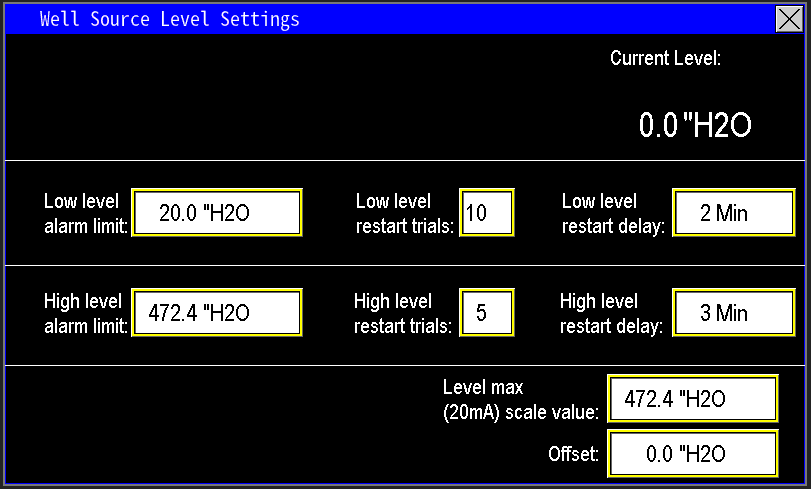¶ Well Source Level Transmitter
The well source level transmitter measures the water level in the sump or supply source for the well pump. These settings (image 1.1) configure the transmitter for accurate level detection and include protective parameters to prevent damage to the well pumps. Proper setup ensures reliable operation and safeguards against low or excessive water levels that could harm the pump or system.

¶ Low Level alarm limit, restarts, and delay
The low level alarm prevents the well pump from operating when water levels fall too low, protecting the pump and seals from damage (image 1.2). When the low level alarm is triggered, it remains active until water levels rise back into the safe operating range.
Once levels recover, the restart delay timer begins (e.g., 2 minutes). If the water level stays above the low alarm threshold during this delay, the pumps will restart. This cycle can repeat up to the specified number of restart trials (e.g., 10 times). If the low level alarm occurs again after all attempts are exhausted (the 11th time), the system will trigger a hard fault, indicating a persistent issue. This requires site inspection to identify and fix the underlying cause of the water level problem before the pumps can be restarted.

¶ High Level alarm limit, restarts and delay
The high level alarm operates similarly to the low level, but it does not cause a fault or shutdown of the well pump (image 1.3). When the water level reaches the high alarm limit, the alarm activates and remains until the level drops back into the normal operating range.
Once the water falls below the high alarm threshold, the restart delay timer (e.g., 10 minutes) begins. During this period, if the level stays below the alarm limit, the timer continues. After the delay, if the level remains below the threshold, the alarm resets, indicating a return to normal. This process can repeat multiple times, up to the configured number of restart trials (e.g., 20).
If the high level alarm occurs again after all allowed retries (e.g., on the 21st occurrence), the alarm will remain active and will not reset until manually addressed. This indicates a persistent problem with the sump or supply system, requiring site inspection to identify and resolve the issue causing continuous overfilling or high water levels.

¶ Transmitter scaling and offset
To ensure the level readings are accurate, set the Level Max (20mA) scale value to match the maximum level range specified on the transmitter (image 1.4). Check the transmitter's maximum rating in its documentation or directly at the device, then input that value into the Level Max (20mA) setting.
The offset represents the distance between the bottom of the tank and the bottom of the transmitter. This adjustment allows the transmitter to be installed above the tank bottom without being affected by mud or debris, while still accurately measuring the water level — including the space below the transmitter.
